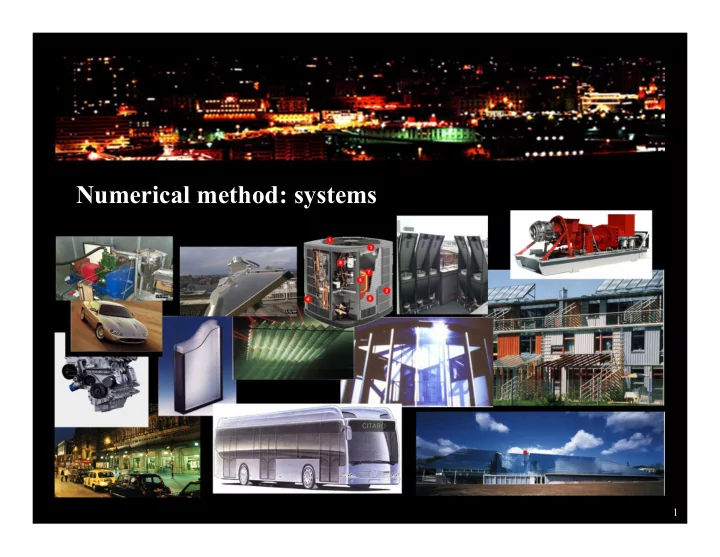

Numerical method: systems 1
Equipment performance: dynamic and non-linear Condenser temp.: 20 C, 30 C, 40 C, 50 C heat pump boiler gas turbine fuel cell wind turbine photovoltaics Issues: dynamic response, conditions monitoring, hybrid systems design and control. 2
Plant and systems simulation Two approaches: Sequential, where components are replaced by an equivalent input/output relationship so that the output from one component becomes the input to the next. Iteration is then employed to achieve solution convergence throughout the network. Simultaneous, where plant components are represented by finite volumes and corresponding conservation equations added to the whole system matrix equation. 3
Sequential vs. simultaneous: pros and cons Sequential approach using black-box, input-output models: supports system design (sizing components); allows checking that components will work together; supports testing of system control strategies; problems with inter-component dependencies; fixed parameters not valid in off-design conditions. Simultaneous approach using full numerical discretisation components have a description of the fundamental processes in each component; can be used to optimise the internal design of each component; does not rely on ‘design-condition’ parameters; can be used to study control variables within components and globally; requires detailed information (e.g. geometry, material properties) that is not always available from manufacturers. 4
Example system: ground and air source heat pump A, B, C: Evaporation and sensible heating of refrigerant in the evaporator (heat transfer from the colder source): convection from source fluid to heat exchanger surface; conduction through heat exchanger wall; convection to boiling refrigerant. D: Electrical energy converted into potential energy (pressure) and heat (temperature increase) in compressor. useful 3 typically COP ( ) Heating paid for 1 E, F, G: Condensation and sensible cooling of refrigerant in the condenser (heat transfer to hotter sink): convection from condensing refrigerant; conduction through heat exchanger wall; convection from heat exchanger surface to supply air. H: Pressure drop and cooling across expansion valve. 5
Heat pump: sequential approach Parameters or a simple model, e.g. a 𝑄 = 1 2 � 𝜍𝐵𝐷𝑤 � wind turbine: Inputs Component model Outputs Parameters Inputs Outputs Manufacturer data (performance map) Fluid properties (constant) Leaving water Entering water temperature temperature & flow Leaving air Entering air temperature & temperature, humidity humidity & flow Electrical power On/off signal Heat flows 6
Heat pump: simultaneous approach 7
Variable discretisation levels Return air Refrigerant 8
Discretising plant 9
Gas central heating system 10
Solar energy collector with energy storage 11
Building-integrated photovoltaic system 12
Fuel cell system 13
TRNSYS – low energy house with heat pump http://www.trnsys.com/ 14
ESP-r: linked building, plant and air/water flow network [Contained in NLiv] StratTank BoostHeat BHPump DHWDraw 7 8 27 8 24 1 23 2 T_IU 5 2 5 29 1 T_SPS Monitoring [Contained tn Nliv] point Temp 3 28 9 and ṁ STankFlow IPCN N SDHW STankR1 21 22 SDHWPump IPCMP SDHWFlow ValSDHWF IPNO 2 1 D 6 [Contained in Liv] 20 7 4 3 13 LivUnFRad NLivUnFRad [Contained Flat plate in NLiv] solar 11 14 12 10 19 collector 24 3 4 SDHWReturn ValSDHWR 18 6 STankR2 [Contained in ambient] 2 1 2 1 18 19 21 ValHP_DHW_F 25 22 ASHPPump ASHP Val_NLiv 11 12 Val_Liv 9 10 ASHPFlow 14 NLivFlow 17 15 13 20 2 15 17 16 LivT_op 26 25 1 30 28 16 23 NLivT_op 26 merge01 ASHPReturn ValHP_DHW_R Dummy [Contained in NLiv] 27 15
Hydrogen fuel cells 16
Renewable energy Homer (http://homer.ucsd.edu/homer/) Retscreen (https://www.nrcan.gc.ca/energy/software- tools/7465) 17
Distributed/embedded generation Power station ………… 1 @ 2000 MW Wind ……. ………… 100 @ 20 MW Combined heat & power Marine …………… 4,000 @ 0.5 MW heat pump CHP …………… 40,000 @ 0.05 MW ducted wind turbines Urban RE ……… 200,000 @ 0.01 MW RE systems 3-5 times greater if the requirement is to match energy production. Requires a photovoltaic cells combined buildings/systems model. gas turbine energy s torage CHP gas turbine PV wind turbine + - converter converter inverter inverter converter Conventional Demand Built supply reshaping Environment connection measures 18
Embedded generation, Lighthouse Building in Glasgow Demand reduction through transparent insulation, advanced glazing and smart control. PV: 0.7 kW e DWT: 0.6 kW e PV hybrid: 0.8 kW e / 1.5 kW h total demand: 68 kWh/m 2 .yr total RE supply: 98 kWh/m 2 .yr Issues: accommodating the grade, variability and unpredictability of energy sources/demands; hybrid systems sizing and maintenance; strategies for co-operative control of stochastic demand and supply; active network management for network balancing, fault handling and power quality maintenance. 19
Tidal stream energy … the oscillating aerofoil driving hydraulic accumulators … horizontal axis turbines evolved from wind power technology Marine Current Turbines’ 300kW prototype (11m dia.) Engineering Business’ Stingray device … and contra-rotating devices Challenges: aquaculture impact reduced reactive torque minimises the simplify moorings reaction torque limit corrosion and abrasion on the structure maintenance and safety issues power take-off at low rotation speed Nautricity’s 500 gearing reduction/elimination kW prototype power transmission/grid access land access and use phased operation of different sites 20
Approch is universally applicable 21
Recommend
More recommend